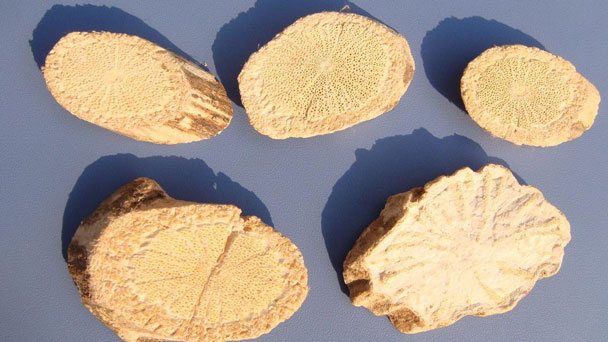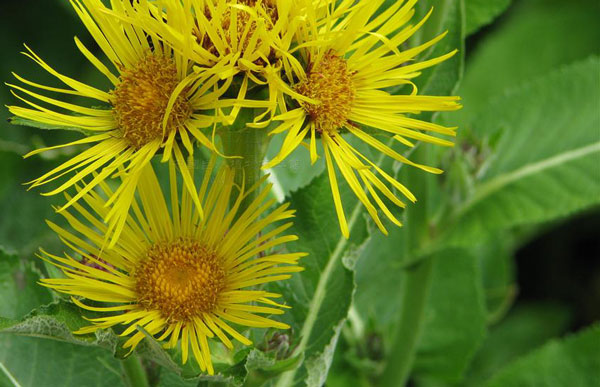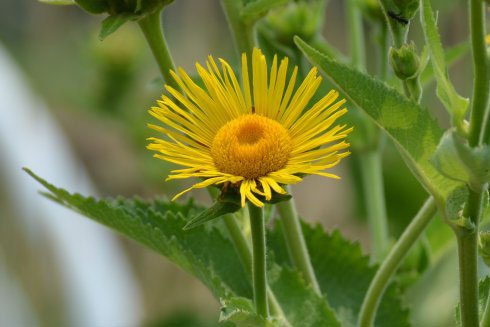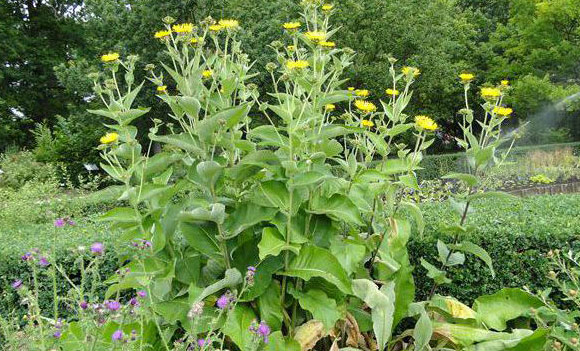Elecampane Plant: Growing & Care for Inula helenium
Written by Iris
Oct 28 2021

Elecampane, scientific name Inula helenium, this beautiful plant can grow up to 4 feet tall and produce large green leaves. Elecampane produces bright yellow flowers with thin petals. Elecampane was an important medicine used by the Greeks and Romans to aid digestion. Elecampane is used as an antiseptic to treat wounds or to help lung health. Even when the roots are harvested for medicinal use, the herb is easily resown, so there are always more seeds appearing the following spring.
The only concern about growing elecampane plants is that they do need some room. Plan on giving Elecampane two to three feet of space around each one to accommodate the leaves and roots in a garden setting.
Although some herbs can be challenging to start from seed, elecampane is very easy. It's a light-dependent germinator, so be careful not to bury it deeply. Sprinkle the Elecampane seeds where you want it to grow, then pat them down lightly with a bit of soil strewn over the top to hold them in place. Germination usually happens within two weeks.
Elecampane transplants well, so you can also start seeds in soil blocks or pots. I usually start my elecampane in soil blocks in the spring or summer. I tamp the seeds down on top of the blocks and keep them moist until germination. Once the seedlings are well established, Transplant the blocks out into the garden.
After a year or two in the garden, your elecampane will be ready to harvest.
Elecampane (Inula helenium) will often form only vegetative growth the first year but will flower prolifically the next year. Plants in some climates will spread each year and require division approximately every third year. In perfect conditions Elecampane can also self seed.
Select a healthy piece of root that is about 2 inches long and contains a bud or eye.
Plant each Elecampane cutting about 12 inches deep, spacing them at least 12 inches apart.
Water the area until the ground freezes. In spring, water carefully to keep the soil moist.
The resulting Elecampane should be mature in two years.


Read Next:
Top 10 Most Beautiful Roses in the World
Top 10 Most Beautiful Flowers in the World
26 Best Autumn Flowers to Plant for Fall Color in Garden
How to Grow Elecampane PlantGrowing Elecampane from SeedsGrowing Elecampane from Root CuttingsHow to Care for Elecampane PlantElecampane LightingElecampane Soil CareElecampane WateringElecampane Temperature & Humidity CareElecampane Fertilizer CareElecampane PruningVarieties of Elecampane PlantElecampane Plant Care FAQHow do you preserve elecampane roots?Is Inula helenium invasive?Is elecampane a perennial?Where is Elecampane native to?
How to Grow Elecampane Plant
Growing Elecampane from Seeds
Start seeds indoors in flats 6 to 8 weeks before the date of the last frost.The only concern about growing elecampane plants is that they do need some room. Plan on giving Elecampane two to three feet of space around each one to accommodate the leaves and roots in a garden setting.
Although some herbs can be challenging to start from seed, elecampane is very easy. It's a light-dependent germinator, so be careful not to bury it deeply. Sprinkle the Elecampane seeds where you want it to grow, then pat them down lightly with a bit of soil strewn over the top to hold them in place. Germination usually happens within two weeks.
Elecampane transplants well, so you can also start seeds in soil blocks or pots. I usually start my elecampane in soil blocks in the spring or summer. I tamp the seeds down on top of the blocks and keep them moist until germination. Once the seedlings are well established, Transplant the blocks out into the garden.
After a year or two in the garden, your elecampane will be ready to harvest.
Elecampane (Inula helenium) will often form only vegetative growth the first year but will flower prolifically the next year. Plants in some climates will spread each year and require division approximately every third year. In perfect conditions Elecampane can also self seed.
Growing Elecampane from Root Cuttings
Growing elecampane from cuttings in the fall, after harvesting the root.Select a healthy piece of root that is about 2 inches long and contains a bud or eye.
Plant each Elecampane cutting about 12 inches deep, spacing them at least 12 inches apart.
Water the area until the ground freezes. In spring, water carefully to keep the soil moist.
The resulting Elecampane should be mature in two years.

How to Care for Elecampane Plant
Elecampane Lighting
Elecampane grows best in part shade but will tolerate full sun.Elecampane Soil Care
For Elecampane (Inula helenium), all soil types are tolerated but damp clay loam with acidic to neutral soil is ideal. Slightly moist soils, with good drainage, will result in better performance as this replicates the native habitat.Elecampane Watering
Water is needed to keep the soil moist but not wet when growing Elecampane. As a wildflower, elecampane does not require a precise watering schedule, but proper, deep watering will help produce healthy roots for harvesting.Elecampane Temperature & Humidity Care
Elecampane (Inula helenium) grows in a variety of climate types and temperatures, but Elecampane grows best in areas with mild summers and cold winters. Elecampane (Inula helenium) does not grow well in very hot and humid areas.Elecampane Fertilizer Care
There is no need to feed elecampane flowers with commercial fertilizers or flower food, and organic feeding is best if you plan to harvest the roots for medicinal uses. Simply top-dress the soil with compost in spring.Elecampane Pruning
Prune Elecampane in early spring to remove the dead stems from winter.
Varieties of Elecampane Plant
There are around 100 species in the Inula genus. A vintage herb, Inula helenium is an ingredient in absinthe, vermouth and some perfumes. Most types of inula plant have herbal qualities and have been part of treatments for digestive ailments, respiratory illness and to enhance the immune system. The Chinese had information about Inula plants that showed them useful in Eastern medicine as well as the source for xuan fu hua, an important scent. Inula helenium and I. magnifica found growing wild in the United States have naturalized when they escaped from cultivation. The majority of the genus is native to central Asia. Inula verbasscifolia is native to the Balkans and Italy and has foliage like lamb's ears, with fuzzy white hairs.
Elecampane Plant Care FAQ
How do you preserve elecampane roots?
Tincturing is by far the easiest method to preserve elecampane for long-term use. The chopped Elecampane root can be placed into a mason jar and covered with a neutral alcohol such as vodka.Is Inula helenium invasive?
Elecampane is noted as invasive in Oregon and potentially invasive in Wisconsin. It may be wise to nip this one before it has a chance to become really established here.Is elecampane a perennial?
Elecampane (Inula helenium) is a perennial herb in the aster family with a long history of medicinal uses, though such use is less common today. In appearance, it is reminiscent of a sunflower plant, with tall stalks, pale green foliage, and bright yellow flowers with large seed heads in the center.Where is Elecampane native to?
Elecampane looks so exotic in Finland that one immediately suspects that it must be native to another land. During the Age of Utility in Sweden-Finland at the end of the 18th century, there began a search for new useful plants from beyond our borders. Elecampane was one of these finds, and it spread to southern and western Finland in particular. The eastern parts of Finnish Kymijoki belonged at that time to Russia, and the drive to educate the population didn't extend beyond the border. This can still be seen in the way that elecampane and many other old useful plants have spread: they are mainly on the western side of Kymijoki. Elecampane does not grow any further north than central Finland.Read Next:
Top 10 Most Beautiful Roses in the World
Top 10 Most Beautiful Flowers in the World
26 Best Autumn Flowers to Plant for Fall Color in Garden
Latest Updated
- Benefits of Bugleweed - 7 Science-backed Health Benefits
- Bugleweed Dangers & Side Effects - Is It Poisonous?
- How to Plant Evergreen Trees - What You Should Know
- When to Plant Evergreens - Grow Guide for Evergreen Trees
- 12 Wonderful Evergreen Shrubs for Your Garden
- 12 Popular Evergreen Plants with Pictures for Beginners
- When And How To Prune A Lilac Bush Like a Pro
- How to Grow & Care for Lilac Vine (Hardenbergia Violacea)
- Japanese Lilac Tree (Syringa Reticulata) Care & Propagation Guide
- Shumard Oak Pros and Cons - What to Know
Popular Articles
- Winter maintenance of Antirrhinum Majus
- How to Grow Terminalia Mantaly Tree
- How to Grow and Care for Crossostephium Chinense
- How to grow Antirrhinum Majus in spring
- Peristeria Elata (Dove Orchid) Profile: Info & Care Guide
- Underwatered Snake Plant (Sansevieria Trifasciata) - Signs And How To Fix
- How to Care for Brazilian Jasmine Plant (Mandevilla Sanderi)
- How to Grow & Care for Graptopetalum Purple Delight in Summer
- Rosa Chinensis (China Rose): Plant Growing & Care Tips
- How to Care for Baby Sun Rose (Aptenia Cordifolia)